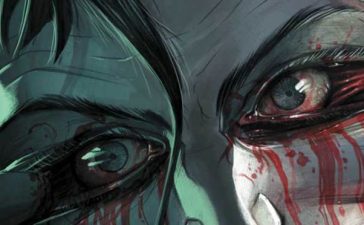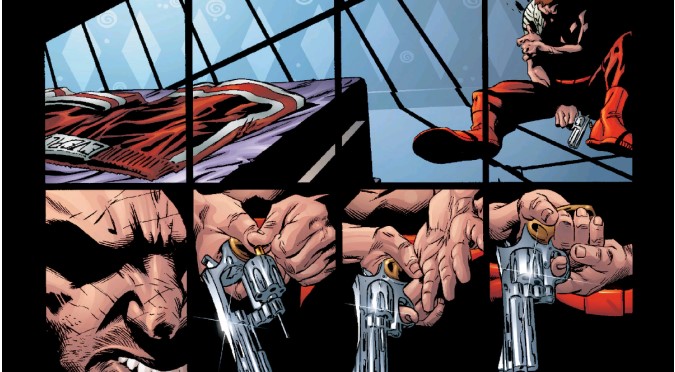
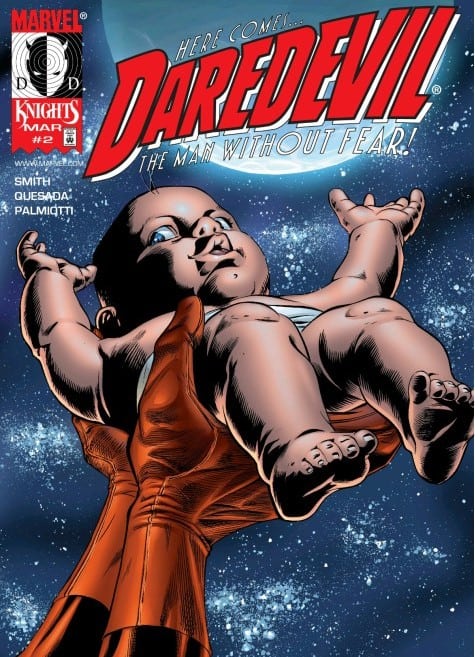 In the 1990s, Marvel was in a slump due to the crash of the comic industry’s speculator boom. In an attempt to boost sales, Marvel outsourced several characters to an independent company, Event Comics. This run was to be known as Marvel Knights. Enter Kevin Smith, Joe Quesada & Jimmy Palmiotti on Daredevil: Guardian Devil, a comic that helped define their careers, pull Marvel out of its slump, and opened the way for more prominent film and television writers to write comics. It marked a turning point in the industry and helped make Marvel the superpower it is today, pun totally intended. It also happens to be the very first Daredevil story I’d ever read.
In the 1990s, Marvel was in a slump due to the crash of the comic industry’s speculator boom. In an attempt to boost sales, Marvel outsourced several characters to an independent company, Event Comics. This run was to be known as Marvel Knights. Enter Kevin Smith, Joe Quesada & Jimmy Palmiotti on Daredevil: Guardian Devil, a comic that helped define their careers, pull Marvel out of its slump, and opened the way for more prominent film and television writers to write comics. It marked a turning point in the industry and helped make Marvel the superpower it is today, pun totally intended. It also happens to be the very first Daredevil story I’d ever read.
Daredevil: Guardian Devil‘s plot is nearly impossible to explain without spoiling it, so if you haven’t read it, you may want to stop reading it now and seek this comic out. It’s definitely worth discovering the twists and turns for yourself. You have been warned. That said, here’s a quick summary.
After Daredevil’s long-time love interest, Karen Page, gets a job as a radio DJ in Los Angeles and leaves Matt Murdock, he starts suffering from a crisis of faith and Catholic guilt. A strange sixteen year old virgin mother comes to him for help, claiming that her daughter is Christ reborn through an immaculate conception and she knows his secret identity. She leaves the child with Matt before disappearing. Matt decides to investigate, pawning the little girl off to his old flame, Black Widow. An old man called Mr. Macabes later comes to Matt, revealing that he knows that Murdock is Daredevil and that the child is, in fact, the anti-Christ. The man gives him a cross and leaves. Before he can say “when it rains, it pours,” Karen returns to his apartment in tears, revealing that she’s H.I.V. positive and Foggy Nelson is charged with murdering a client. Meanwhile, Matt is growing more and more paranoid. He’s beginning to believe that the little girl really is the anti-Christ. He’s wrong, of course. She’s actually the reincarnation of his mentor, Stick. That’s not a joke. Daredevil: Ninja, look it up.
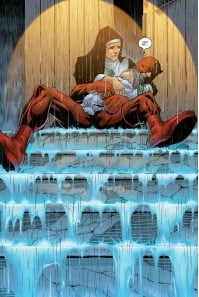 This story, at it’s basic core, is about Matt Murdock’s crisis of faith as his world comes crumbling around him for the umpteenth time. It shares many similarities with Frank Miller’s Born Again. The arc is referenced during the denouement when it is revealed that that dying Mysterio was behind the whole thing. Why Mysterio? Well, he adopted Daredevil as his foe because he saw a bit of himself in old hornhead. When Mysterio is diagnosed with cancer, he wanted to create one epic “swan song” and because Spider-man was still in the midst of the clone saga, he chose Daredevil because they were both second stringers in the Marvel universe. He sees himself as an artist and wants to create an epic narrative as he went down fighting his nemesis. This leads the one of the best and most brutal speeches by Daredevil in the entire arc where he deconstructs Mysterio’s evil plan as cliched and overdone. Mysterio is not an artist. In fact, he has “not had an original idea in his life.” Daredevil refuses to kill him because he finds him too pathetic. Instead of going out fighting as he planned, Mysterio dies by his own hand as a broken man.
This story, at it’s basic core, is about Matt Murdock’s crisis of faith as his world comes crumbling around him for the umpteenth time. It shares many similarities with Frank Miller’s Born Again. The arc is referenced during the denouement when it is revealed that that dying Mysterio was behind the whole thing. Why Mysterio? Well, he adopted Daredevil as his foe because he saw a bit of himself in old hornhead. When Mysterio is diagnosed with cancer, he wanted to create one epic “swan song” and because Spider-man was still in the midst of the clone saga, he chose Daredevil because they were both second stringers in the Marvel universe. He sees himself as an artist and wants to create an epic narrative as he went down fighting his nemesis. This leads the one of the best and most brutal speeches by Daredevil in the entire arc where he deconstructs Mysterio’s evil plan as cliched and overdone. Mysterio is not an artist. In fact, he has “not had an original idea in his life.” Daredevil refuses to kill him because he finds him too pathetic. Instead of going out fighting as he planned, Mysterio dies by his own hand as a broken man.
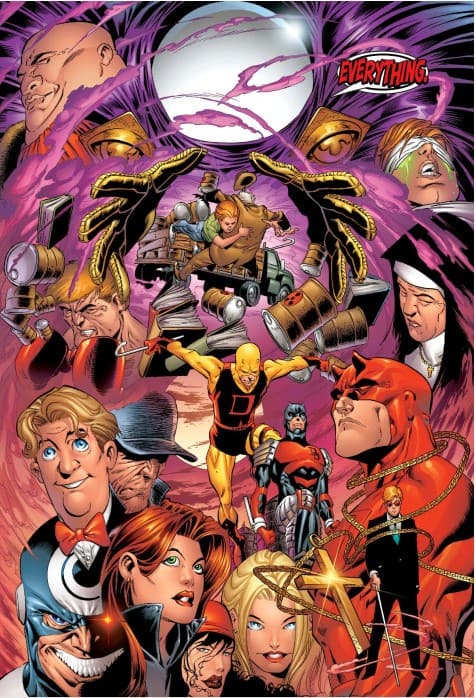
The artwork and layouts are fantastic, with a heavy emphasis on shadows. It gives the story a very gothic feel. The story is very dialogue heavy, but the way the panels are laid out, it doesn’t feel that way. It flows very naturally. One standout sequence would be in the very beginning of part six as Daredevil contemplates suicide after the death of Karen at the hands of Bullseye. It really gets the emotion through. The panels layouts themselves actually resemble stained glass windows at several points, perfectly fitting the religious themes.
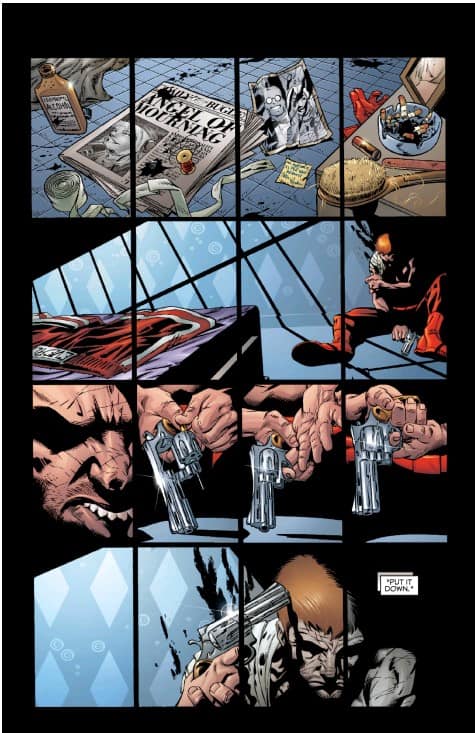
That said, there is a teensy weensy really big problem in the story. That would be the fact that female characters tend to be treated less as characters and more as motivation for angst by the male characters. Let’s talk about the elephant in the room first: the treatment of Karen Page. Karen is convinced that she is H.I.V. positive and, a few issues later, she’s killed off by Bullseye to make Daredevil’s already miserable life even worse. In the intervening time during the story, we learn little about what she is actually going through. Whenever she gets a point of view inner monologue, it’s less about what it’s like having a terminal illness and more about how she’s all take and no give with Matt. The reason she’s led to believe that she has a terminal illness isn’t to further her character. It’s meant to make Matt angst even more. It’s a classic women in refrigerators scenario. To add insult to injury, she didn’t even have H.I.V. in the first place. This, I think, is a misstep on the writer’s part. There is a lot of story potential in a superhero whose girlfriend has AIDS and could help develop the two characters’ relationship even more.
Most of the female character were reduced to sympathetic plot devices. They tended to be mostly innocent victims that were pretty casually killed off. No one exemplifies that better than Gwyneth the alleged anti-Christ’s mother. She’s only fifteen when Mysterio has her kidnapped, drugged, and artificially inseminated, and only sixteen when he has her parents murdered and when he later kills her. All of those atrocities are only mentioned in passing. She isn’t a character, she’s just the plot catalyst, and once she’s no longer needed, she’s pretty callously killed off.
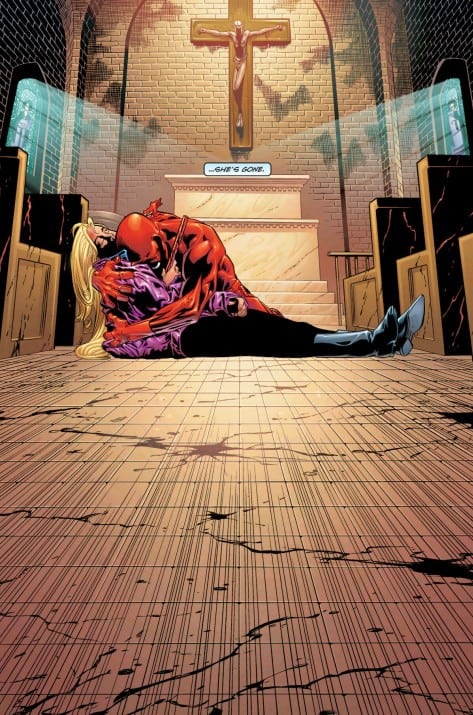
Was the fridging intentional on Kevin Smiths part? I highly doubt it. Back then, the Women in Refrigerators trope was just being pointed out. It was probably done more out of ignorance than malice. When I first read it, the only women in refrigerators that I knew of were Lucy and Ethel from that one episode of I Love Lucy, so I hadn’t noticed the problem. Now though? It’s pretty distracting and definitely detracts from the rest of the story. Does he still be deserve to be called out for it? Yes. The women in refrigerator’s trope was and is still an issue. As the old adage goes, “the squeaky wheel gets the grease”. The only way that there can be a change is if writers are called out for it, but are still given room to improve. When people point out that a character has been stuffed in the fridge, what they are saying is that they don’t want to see this character’s life devalued and reduced to cheap angst for the protagonist.
Overall, is this still an enjoyable read? Yes. It has a great mystery, is well drawn, and wonderful character moments. The treatment of the female characters is very problematic, and something that needs to be brought up and discussed though. In a way, it reminds me of The Killing Joke. Both stories are highly praised and deserve all of it, but have the highly problematic treatment the female characters. Even with this, Guardian Devil is a great read and I still recommend it.






